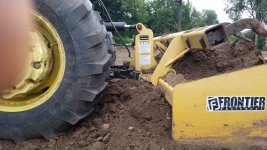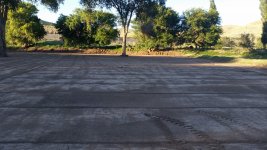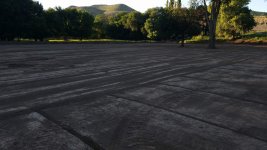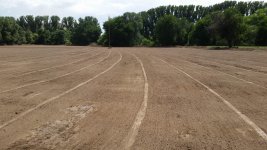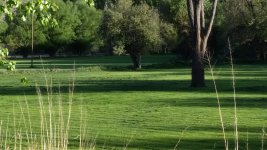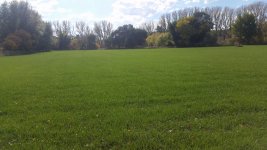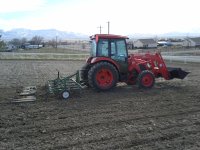crmorse
Member
I have 2.5 acres that I just reclaimed from mostly small trees. I've done a soil test so I know what I need to do amendments-wise but I need to get it leveled first and then cultivated.
What I'm not sure of is how best to break up, smooth out, and level the field. It was cleared via the push over method with a track loader so I have about a dozen stump holes scattered around. I also need to put in a drainage swale. Since I have a drone available, I figured this was as good an excuse as any to go fly so here's an overview video of it.
[video=vimeo;228749754]Field 2 Flyover[/video]
Field 2 Above All on Vimeo
Tractors available:
Implements in the barn:
What I'm currently thinking I should do.....
My short-term goal is to plant winter wheat in October. But, I'd rather take the time now to do it right so the field stays nice than rush and fight issues every time I work it from now on.
My biggest challenge, at least for me, is what I'll call "macro" leveling.... I can see a hole and drag some nearby dirt into. It's much harder for me to see if all I've really done is just create a wider but shallower depression. I guess that's the really the trick anyway? I guess I just have to frequently get off, get low to the ground, and look around... If you experienced hands have any tips on how to do this better, I'm all ears... (Note: I only have about 100 hours under my seat spread across all 3 of the above)
On the swale, there's already a rough path I put in with the track loader just to get it to drain all this extra rain we're getting this year. But I really need to move it over and straighten it out so it won't be a pain to work around forevermore. For that, I'm thinking I take the transit out and drive in grade stakes to set a straight path and establish the drainage slope. Then use the backhoe to excavate the swale bottom. From there, I'm not really sure what to do. I've tried using both the back blade and the box blade to slope the sides and all I really did was get the Kubota stuck a bunch of times. (Seriously, it's rained so much this year I've consider relocating to Seattle for the sunshine!) The tracker loader doesn't get stuck but it's basically impossible (at least with my skill level) to set any kind of intentional angle with it. The best luck I've had so far is backing up perpendicular to the swale with the box blade and dragging forward a few times. I can't get a consistent angle that way but at least its sloping the banks. It just kills my neck craning around for hours at a time.
Assuming I do the above correctly. The second challenge will be moving the dirt excavated out of the new swale back to the existing drainage ditch location leveling that back out. I guess it'll just take getting muddy a bunch and then waiting for the old path to dry up enough to work it again after the new swale has taken over the water flow. I realize this paragraph probably doesn't make any sense. If this thread sticks around I'll post pictures along the way that will help a lot.
If you read this far, thank you. If you can offer any suggestions or help thank you twice!
Sincerely,
City boy learning the country ways (and loving it)
What I'm not sure of is how best to break up, smooth out, and level the field. It was cleared via the push over method with a track loader so I have about a dozen stump holes scattered around. I also need to put in a drainage swale. Since I have a drone available, I figured this was as good an excuse as any to go fly so here's an overview video of it.
[video=vimeo;228749754]Field 2 Flyover[/video]
Field 2 Above All on Vimeo
Tractors available:
- John Deere 455G Track Loader (great for digging but sucks for leveling because you can't tilt the blade)
- Kubota L47 TLB with loaded rear tires and 3PT w/TnT (brute force but I do wish it had R1 tires... R4s just spin in mud).
- Ford 8N with R1s (Tired and worn out but still works harder than I can)
Implements in the barn:
- 6' double-gang disc
- 6' Rototiller
- 7-tine chisel plow
- 6' box blade with scarifiers
- Subsoiler
- Single row cultivator
- beastly spring tooth cultivator of some sort (What is this thing called? - OrangeTractorTalks - Everything Kubota)
- 6-way back blade
What I'm currently thinking I should do.....
- couple of passes with either the monster rake thingy or the chisel plow depending on whichever seems to break it up better and pull up the roots
- many passes with the box blade to level out the highs and lows. Probably have to alternate with chisel above unless tipping forward the rippers can re-dig deep enough
- spot cut/fill high and low places with front bucket
- disc or rototill
- plant
My short-term goal is to plant winter wheat in October. But, I'd rather take the time now to do it right so the field stays nice than rush and fight issues every time I work it from now on.
My biggest challenge, at least for me, is what I'll call "macro" leveling.... I can see a hole and drag some nearby dirt into. It's much harder for me to see if all I've really done is just create a wider but shallower depression. I guess that's the really the trick anyway? I guess I just have to frequently get off, get low to the ground, and look around... If you experienced hands have any tips on how to do this better, I'm all ears... (Note: I only have about 100 hours under my seat spread across all 3 of the above)
On the swale, there's already a rough path I put in with the track loader just to get it to drain all this extra rain we're getting this year. But I really need to move it over and straighten it out so it won't be a pain to work around forevermore. For that, I'm thinking I take the transit out and drive in grade stakes to set a straight path and establish the drainage slope. Then use the backhoe to excavate the swale bottom. From there, I'm not really sure what to do. I've tried using both the back blade and the box blade to slope the sides and all I really did was get the Kubota stuck a bunch of times. (Seriously, it's rained so much this year I've consider relocating to Seattle for the sunshine!) The tracker loader doesn't get stuck but it's basically impossible (at least with my skill level) to set any kind of intentional angle with it. The best luck I've had so far is backing up perpendicular to the swale with the box blade and dragging forward a few times. I can't get a consistent angle that way but at least its sloping the banks. It just kills my neck craning around for hours at a time.
Assuming I do the above correctly. The second challenge will be moving the dirt excavated out of the new swale back to the existing drainage ditch location leveling that back out. I guess it'll just take getting muddy a bunch and then waiting for the old path to dry up enough to work it again after the new swale has taken over the water flow. I realize this paragraph probably doesn't make any sense. If this thread sticks around I'll post pictures along the way that will help a lot.
If you read this far, thank you. If you can offer any suggestions or help thank you twice!
Sincerely,
City boy learning the country ways (and loving it)
Last edited:
